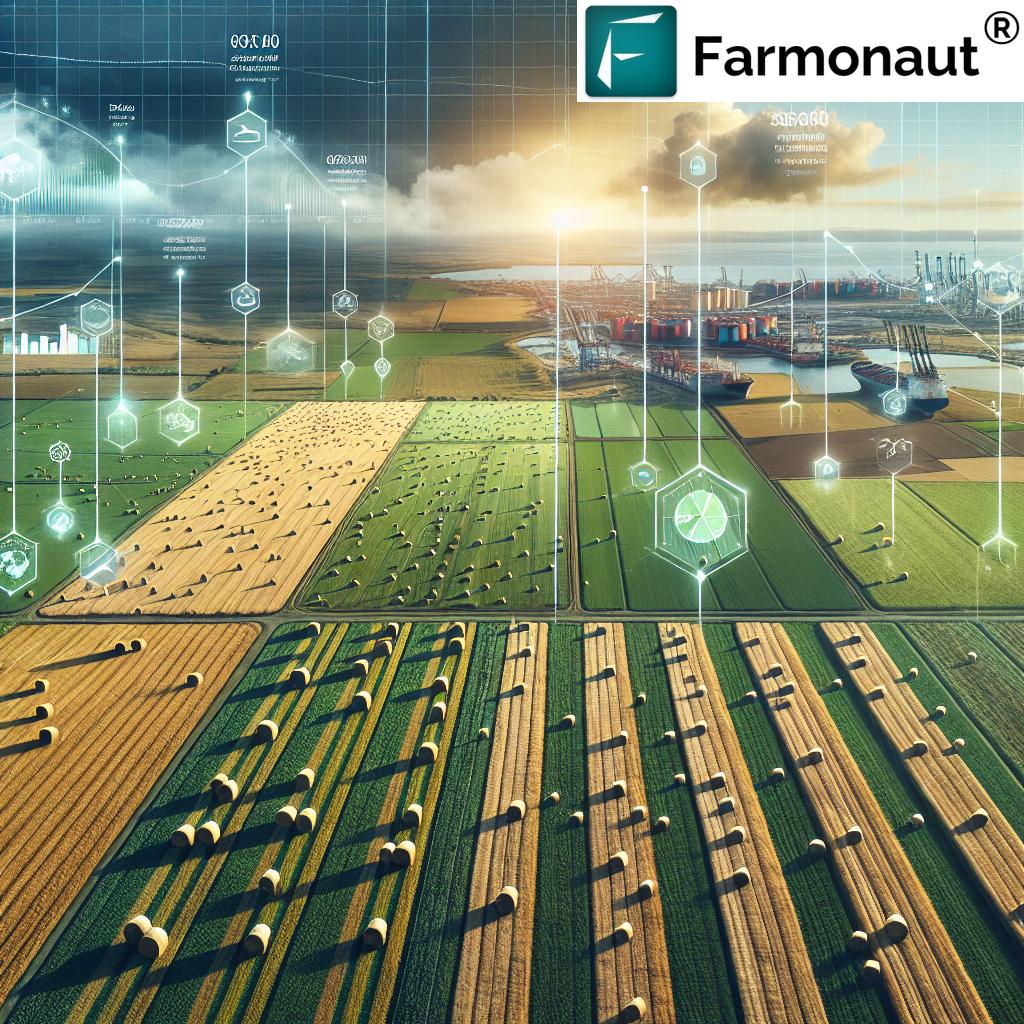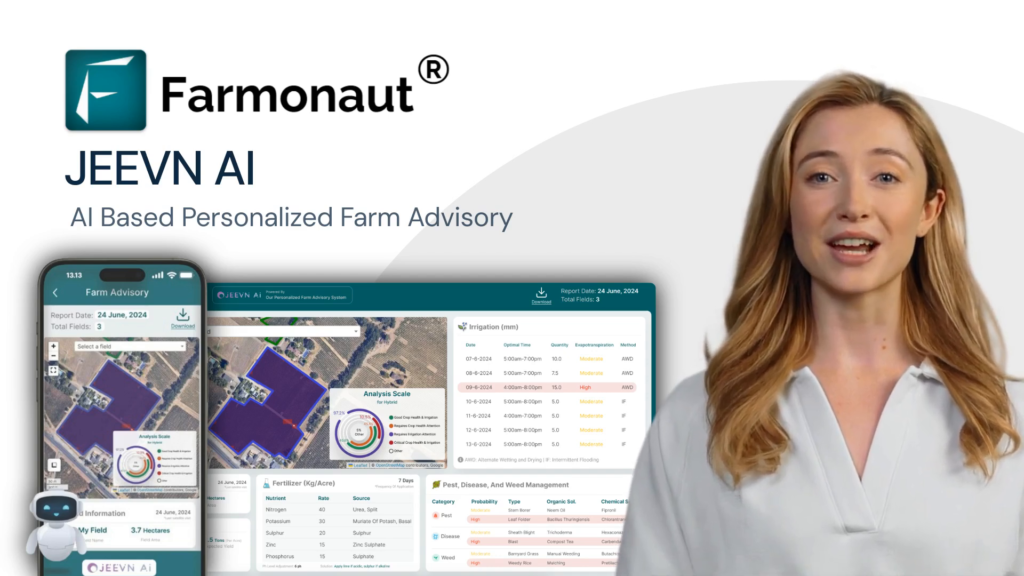Hay Market Surge: 2020 Alfalfa Prices Climb as U.S. West Coast Exports Soar – Farmonaut’s Industry Analysis
“U.S. hay exports reached 415,057 metric tons, with West Coast demand driving a $6 per ton increase in alfalfa prices.”
Welcome to our comprehensive analysis of the hay market trends and alfalfa pricing dynamics that have been shaping the forage industry in recent months. At Farmonaut, we’re committed to providing farmers and agricultural stakeholders with the most up-to-date insights and tools to navigate the ever-changing landscape of crop production and market fluctuations. In this blog post, we’ll delve deep into the factors driving the surge in hay prices, particularly alfalfa, and explore the implications for farmers, exporters, and the broader agricultural sector.
The Alfalfa Price Surge: Understanding the Market Dynamics
The United States Department of Agriculture (USDA) has recently reported significant fluctuations in hay and alfalfa prices, with a notable $6 per ton increase for alfalfa in April. This price hike has sent ripples through the industry, prompting us to take a closer look at the underlying causes and potential long-term effects on the market.

Several factors have contributed to this upward trend in alfalfa prices:
- Strong Export Demand: The West Coast has seen a surge in export demand, particularly from countries in Asia, driving up prices for high-quality alfalfa.
- Weather Impacts: Late spring storms have affected first cuttings in many regions, leading to supply constraints and quality issues.
- Increased Domestic Consumption: A growing dairy industry has boosted domestic demand for premium alfalfa hay.
- Transportation Costs: Rising fuel prices and logistical challenges have increased the delivered cost of hay to both domestic and international markets.
West Coast Exports: A Key Driver of Market Growth
The West Coast, particularly states like California, Oregon, and Washington, has emerged as a powerhouse in the hay export market. In recent months, U.S. hay exports have reached an impressive 415,057 metric tons, with a significant portion shipping out from West Coast ports. This export boom has been instrumental in driving up alfalfa prices and reshaping the domestic market landscape.
Key factors contributing to the West Coast export surge include:
- Proximity to Asian Markets: The strategic location of West Coast ports provides easy access to major hay-importing countries like Japan, South Korea, and China.
- High-Quality Production: The Western states are known for producing premium alfalfa hay, which commands top dollar in international markets.
- Efficient Port Infrastructure: Investments in port facilities have streamlined the export process, making West Coast hay more competitive globally.
- Favorable Trade Relations: Despite some recent tensions, long-standing trade agreements have facilitated steady hay exports to key Asian partners.
Weather Impacts on Crop Production: Navigating Uncertainties
Weather patterns have played a crucial role in shaping the hay market landscape. Late spring storms have affected first cuttings in several key production areas, leading to yield reductions and quality concerns. These weather-related challenges have contributed to the tightening of supply and subsequent price increases.
At Farmonaut, we understand the critical importance of accurate weather forecasting and crop monitoring in mitigating these risks. Our satellite-based crop health monitoring system provides real-time insights into vegetation health, soil moisture levels, and other vital metrics, empowering farmers to make informed decisions about irrigation, fertilizer usage, and pest management.
Access our Web App for comprehensive crop monitoring:
Hay Storage Solutions: Maximizing Quality and Profitability
With the current market dynamics favoring higher hay prices, effective storage solutions have become more critical than ever. Proper hay storage not only preserves quality but also allows farmers to capitalize on market fluctuations by holding inventory when prices are advantageous.
Key considerations for optimal hay storage include:
- Covered Storage: Utilizing barns or covered structures to protect hay from moisture and sunlight degradation.
- Proper Stacking: Implementing efficient stacking techniques to maximize space utilization and minimize spoilage.
- Ventilation: Ensuring adequate airflow to prevent mold growth and maintain hay quality.
- Moisture Monitoring: Regularly checking moisture levels to prevent spontaneous combustion and quality loss.
Farmonaut’s precision agriculture tools can assist in monitoring storage conditions, helping farmers maintain optimal hay quality throughout the storage period.
Grass Hay Production: Diversifying the Forage Portfolio
While alfalfa has been the star performer in recent market trends, grass hay production remains an essential component of the forage industry. Many farmers are diversifying their hay crops to include a mix of alfalfa and grass varieties, catering to different market segments and mitigating risk.

Benefits of incorporating grass hay into production include:
- Soil Health: Grass varieties can improve soil structure and reduce erosion.
- Drought Tolerance: Many grass species are more resilient to dry conditions than alfalfa.
- Market Flexibility: Different grass types cater to various livestock needs, expanding market opportunities.
- Reduced Input Costs: Grass hay often requires fewer inputs compared to alfalfa, potentially improving profit margins.
“Hay stocks rose by 37% in 2020, creating unique market dynamics for pricing and availability in the forage industry.”
Agricultural Commodity Exports: Navigating Global Markets
The surge in hay exports, particularly from the West Coast, highlights the growing importance of international markets for U.S. agricultural commodities. As global demand for high-quality forage continues to rise, understanding and leveraging export opportunities becomes crucial for hay producers and exporters.
Key considerations for successful hay exports include:
- Quality Control: Maintaining consistently high quality to meet international standards and buyer expectations.
- Logistics Management: Optimizing transportation and shipping processes to ensure timely delivery and cost-effectiveness.
- Market Research: Staying informed about global demand trends and emerging market opportunities.
- Regulatory Compliance: Navigating international trade regulations and phytosanitary requirements.
At Farmonaut, we’re committed to supporting farmers and exporters in their global market endeavors. Our precision agriculture tools can help ensure consistent crop quality, while our market insights can inform strategic export decisions.
Explore our API for advanced agricultural data:
Forage Quality Assessment: Ensuring Premium Prices
As hay prices continue to climb, the importance of accurate forage quality assessment cannot be overstated. Buyers, both domestic and international, are willing to pay premium prices for high-quality hay that meets specific nutritional requirements.
Key factors in forage quality assessment include:
- Protein Content: Higher protein levels generally command better prices, especially for dairy-quality hay.
- Fiber Composition: Optimal levels of ADF (Acid Detergent Fiber) and NDF (Neutral Detergent Fiber) are crucial for digestibility and animal performance.
- Moisture Content: Proper moisture levels are essential for storage stability and preventing mold growth.
- Physical Characteristics: Leaf retention, color, and stem thickness all contribute to overall hay quality.
Farmonaut’s advanced satellite imagery and AI-powered analytics can assist farmers in monitoring crop health throughout the growing season, helping to optimize harvest timing and maximize forage quality.
Precision Agriculture for Hay: Optimizing Production Strategies
In an era of rising input costs and volatile markets, precision agriculture techniques have become indispensable for hay producers looking to maximize yields and quality while minimizing expenses. Farmonaut’s suite of precision agriculture tools offers a comprehensive solution for optimizing hay production strategies.
Key benefits of precision agriculture for hay production include:
- Targeted Fertilization: Using satellite imagery and soil analysis to apply fertilizers precisely where needed, reducing waste and improving plant nutrition.
- Irrigation Management: Optimizing water usage through real-time soil moisture monitoring and weather forecasting.
- Pest and Disease Detection: Early identification of potential threats through remote sensing, allowing for timely intervention.
- Yield Mapping: Analyzing field productivity to inform future planting and management decisions.
Download our mobile apps for on-the-go precision agriculture:
Sustainable Farming Practices: Balancing Profitability and Environmental Stewardship
As the hay market continues to evolve, sustainable farming practices are becoming increasingly important, both for environmental stewardship and long-term profitability. Implementing sustainable methods can help farmers reduce input costs, improve soil health, and potentially access premium markets for environmentally friendly products.
Key sustainable practices for hay production include:
- Cover Cropping: Planting cover crops between hay rotations to improve soil structure and nutrient content.
- Integrated Pest Management (IPM): Utilizing natural predators and targeted interventions to minimize pesticide use.
- Conservation Tillage: Reducing soil disturbance to preserve soil structure and organic matter.
- Rotational Grazing: Implementing grazing systems that promote pasture health and biodiversity.
Farmonaut’s precision agriculture tools can support these sustainable practices by providing detailed insights into soil health, plant stress, and overall field conditions.
Agricultural Market Forecasting: Navigating Future Trends
In a rapidly changing agricultural landscape, accurate market forecasting is essential for making informed decisions about planting, harvesting, and marketing hay crops. While predicting exact market movements is challenging, analyzing historical data, current trends, and global economic factors can provide valuable insights for strategic planning.
Key factors to consider in agricultural market forecasting include:
- Global Supply and Demand: Monitoring international production levels and consumption patterns.
- Weather Patterns: Analyzing long-term climate trends and their potential impact on crop yields.
- Economic Indicators: Considering factors such as currency exchange rates and global economic growth.
- Policy Changes: Staying informed about agricultural policies and trade agreements that may affect market dynamics.
Farmonaut’s data-driven insights and AI-powered analytics can assist farmers and industry professionals in making more accurate market predictions and informed business decisions.
Alfalfa Price and Export Trends Comparison
| Year | Average Alfalfa Price ($/ton) | Price Change from Previous Year (%) | U.S. Hay Exports (metric tons) | Export Change from Previous Year (%) |
|---|---|---|---|---|
| 2020 | 180 | +3.4% | 415,057 | +5.2% |
| 2019 | 174 | -2.8% | 394,543 | +1.8% |
| 2018 | 179 | +4.1% | 387,567 | +3.5% |
| 2017 | 172 | -1.7% | 374,458 | +2.1% |
| 2016 | 175 | -3.3% | 366,752 | -0.8% |
Conclusion: Embracing Technology for Hay Market Success
As we’ve explored throughout this analysis, the hay market is experiencing significant changes, with alfalfa prices climbing and West Coast exports soaring. These trends present both challenges and opportunities for farmers, exporters, and other stakeholders in the forage industry. By leveraging advanced technologies and data-driven insights, producers can navigate these market dynamics more effectively, optimizing their operations for both profitability and sustainability.
At Farmonaut, we’re committed to providing the tools and expertise needed to thrive in this evolving landscape. Our precision agriculture solutions, including satellite-based crop monitoring, AI-powered advisory systems, and blockchain-based traceability, empower farmers to make informed decisions, improve crop quality, and capitalize on market opportunities.
As we look to the future, the integration of technology in agriculture will continue to play a crucial role in addressing global food security challenges while promoting sustainable farming practices. By embracing these innovations, the hay and forage industry can not only adapt to current market trends but also position itself for long-term success in an increasingly complex and interconnected global marketplace.
FAQ Section
- Q: What factors are driving the increase in alfalfa prices?
A: The main factors include strong export demand, especially from the West Coast, weather impacts on first cuttings, increased domestic consumption from the dairy industry, and rising transportation costs. - Q: How significant is the West Coast in U.S. hay exports?
A: The West Coast plays a crucial role, with U.S. hay exports reaching 415,057 metric tons, a significant portion of which is shipped from West Coast ports. - Q: How can farmers optimize hay storage to maximize profitability?
A: Key strategies include using covered storage, proper stacking techniques, ensuring adequate ventilation, and regularly monitoring moisture levels. - Q: What are the benefits of incorporating grass hay into production?
A: Grass hay can improve soil health, offer better drought tolerance, provide market flexibility, and potentially reduce input costs compared to alfalfa. - Q: How can precision agriculture tools benefit hay producers?
A: Precision agriculture tools like those offered by Farmonaut can help with targeted fertilization, optimized irrigation management, early pest and disease detection, and yield mapping for improved decision-making.
















